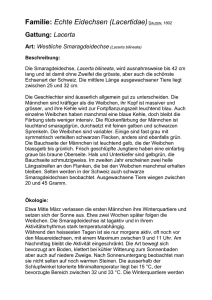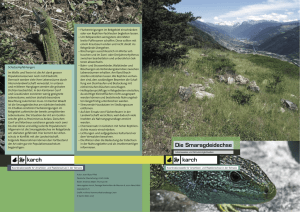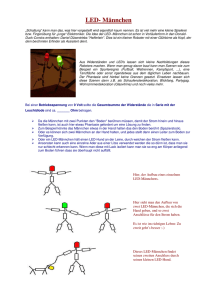smaragdeidechse
Werbung
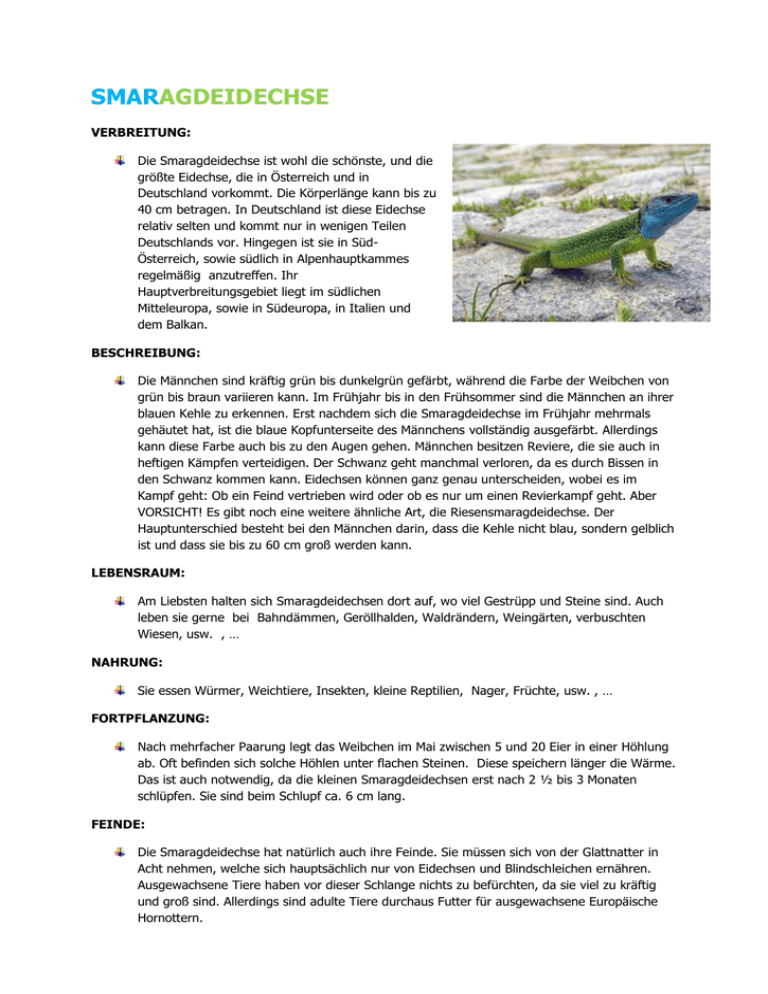
SMARAGDEIDECHSE VERBREITUNG: Die Smaragdeidechse ist wohl die schönste, und die größte Eidechse, die in Österreich und in Deutschland vorkommt. Die Körperlänge kann bis zu 40 cm betragen. In Deutschland ist diese Eidechse relativ selten und kommt nur in wenigen Teilen Deutschlands vor. Hingegen ist sie in SüdÖsterreich, sowie südlich in Alpenhauptkammes regelmäßig anzutreffen. Ihr Hauptverbreitungsgebiet liegt im südlichen Mitteleuropa, sowie in Südeuropa, in Italien und dem Balkan. BESCHREIBUNG: Die Männchen sind kräftig grün bis dunkelgrün gefärbt, während die Farbe der Weibchen von grün bis braun variieren kann. Im Frühjahr bis in den Frühsommer sind die Männchen an ihrer blauen Kehle zu erkennen. Erst nachdem sich die Smaragdeidechse im Frühjahr mehrmals gehäutet hat, ist die blaue Kopfunterseite des Männchens vollständig ausgefärbt. Allerdings kann diese Farbe auch bis zu den Augen gehen. Männchen besitzen Reviere, die sie auch in heftigen Kämpfen verteidigen. Der Schwanz geht manchmal verloren, da es durch Bissen in den Schwanz kommen kann. Eidechsen können ganz genau unterscheiden, wobei es im Kampf geht: Ob ein Feind vertrieben wird oder ob es nur um einen Revierkampf geht. Aber VORSICHT! Es gibt noch eine weitere ähnliche Art, die Riesensmaragdeidechse. Der Hauptunterschied besteht bei den Männchen darin, dass die Kehle nicht blau, sondern gelblich ist und dass sie bis zu 60 cm groß werden kann. LEBENSRAUM: Am Liebsten halten sich Smaragdeidechsen dort auf, wo viel Gestrüpp und Steine sind. Auch leben sie gerne bei Bahndämmen, Geröllhalden, Waldrändern, Weingärten, verbuschten Wiesen, usw. , … NAHRUNG: Sie essen Würmer, Weichtiere, Insekten, kleine Reptilien, Nager, Früchte, usw. , … FORTPFLANZUNG: Nach mehrfacher Paarung legt das Weibchen im Mai zwischen 5 und 20 Eier in einer Höhlung ab. Oft befinden sich solche Höhlen unter flachen Steinen. Diese speichern länger die Wärme. Das ist auch notwendig, da die kleinen Smaragdeidechsen erst nach 2 ½ bis 3 Monaten schlüpfen. Sie sind beim Schlupf ca. 6 cm lang. FEINDE: Die Smaragdeidechse hat natürlich auch ihre Feinde. Sie müssen sich von der Glattnatter in Acht nehmen, welche sich hauptsächlich nur von Eidechsen und Blindschleichen ernähren. Ausgewachsene Tiere haben vor dieser Schlange nichts zu befürchten, da sie viel zu kräftig und groß sind. Allerdings sind adulte Tiere durchaus Futter für ausgewachsene Europäische Hornottern. THE GREEN LIZARD DISSEMINATION: The Green-Lizard is one of the most beautiful and also nearly the biggest lizard in the area of Austria and Germany. Its body length may be up to 40 cm. In Germany the green lizard is relatively rare, and can be found only in some parts. In the south of Austria and in the south of the Alps, it is widely spread. The main dissemination areas are the Balkans, Southern Central Europe, Southern Europe and Italy. DESCRIPTION: The males are strongly green to dark green coloured, whereas the skin colour of the females varies from green to brown. In spring till summer the males are known by their blue throat. After moulting several times in spring, the blue throat of the males is completely discoloured / faded. This colour might also reach their eyes. Males establish a territory which they also try to defend. Sometimes the tail gets lost because of bites which happen during territorial fights. Lizards know exactly what the fight is about: Whether the enemy has just to be chased away or whether it is a territorial fight. But be careful! There is also another kind of Green lizard, the Giant Green Lizard. The main difference concerning the males is that their throats are not blue but yellowish and that the lizard can reach a body length of up to 60 centimetres. NATURAL HABITAT: They prefer living where shrubs and stones are. They also like being at railroad embankments, screes, forest edges, vineyards and scrubland.... FOOD: They eat worms, molluscs, insects, small reptiles, small rodents, fruit, and so on... REPRODUCTION: In May, after multiple pairing, the female lays between five and twenty eggs into a hollow. The hollows are often underneath flat stones which buffer warmth. This is necessary because the little green lizards do not hatch until after two and a half to three months. When they hatch, they are about six centimetres long. ENEMIES The lizard has its natural enemies, of course. They have to beware of a certain type of colubrid – the Smooth Snake, which feeds mainly on lizards and blindworms. Grown-up animals do not have to be afraid of this colubrid, as they are too strong and large. But adult animals might be food/prey for full-grown European Horned Vipers.
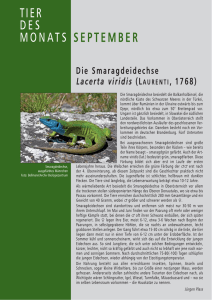

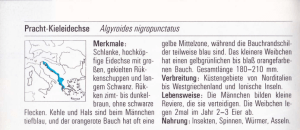
![[g]artenvielfalt in der Green City Frankfurt](http://s1.studylibde.com/store/data/002300504_1-2c3e7c1e2441a055a9b55c89d0ab965e-300x300.png)
